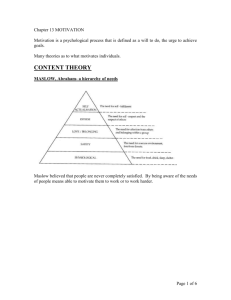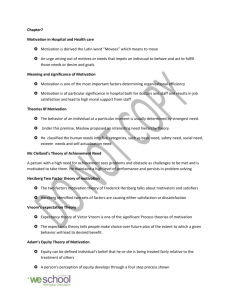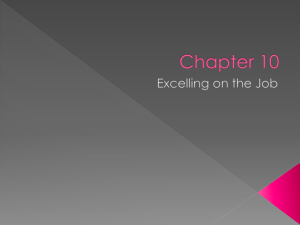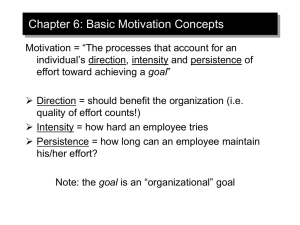Unit * 3 Staffing and motivation
advertisement
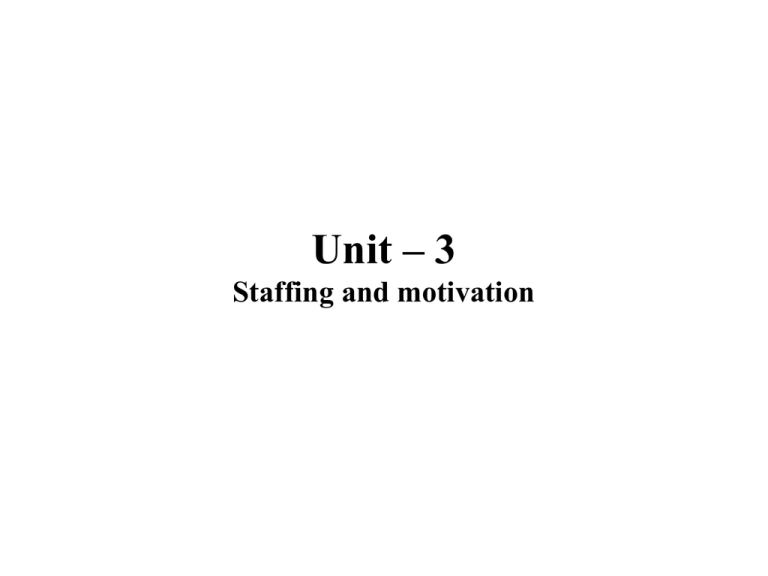
Unit – 3 Staffing and motivation Staffing # Staffing means matching the jobs with people. It is concerned with selection, placements growth and development of people. • • • • Main features of staffing – Staffing involves people Staffing is development oriented Staffing is continuous Staffing is a three step process – Hiring, developing and creating favourable conditions to work. Importance of staffing # People are key to everything in the organization. It helps in the following way• Key to other managerial functions • Designing a sound organization structure • Motivation to do outstanding work Elements of staffing process • • • • • • • Human resource planning Job analysis Recruitment Selection Placement and orientation Training and development Performance appraisal Motivation Scott defined as “Process of stimulating people to action to accomplish desired goal” Features of motivation – • Motivation is internal feeling • Produces goal directed behavior • Contains system orientation • Can be either positive or negative • Motivation means bargaining • Motivation is a complete process • Motivation is different from job satisfaction Importance of Motivation • • • • • Productive use of resources Increased efficiency and output Achievement of goals Development of friendly relationships Stability in work force NEED (deficiency) BEHAVIOR •Work hard •Find another job •Become union member and pressure management Tension reduction The Motivation Framework GOAL •Get a pay raise Theories of motivation Basically three types of theories: 1. Content theories - Insight into the needs of people in the organization, that helps managers understand how needs can be satisfied in the work place • • • • • • Maslow’s Hierarchy of Needs theory Alderfer’s ERG model Hertzberg’r two factor theory Achievement Motivation theory Theory X and theory Y Theory Z 2. Process theories: Focus on why people choose certain behavioral options to satisfy their needs and how they evaluate their satisfaction after they have satisfied these goals. • Equity theory • Vroom’s Expectancy theory • Porter and Lawler model • Goal Setting theory 3. Reinforcement theories: Focus on employee learning of desired behaviors. Argue that the behavior that is rewarded is likely to be repeated. Maslow’s theory Self Actualization Esteem Social Safety Physiological Alderfer’s ERG Model Physiological, Safety – Existence needs: Needs required to preserve human life. They include all of what Maslow termed as physiological needs relating to material safety. Social Needs – Relatedness needs: They refer to all socially intended needs. How people relate to their surrounding social environment. Include need for meaningful social and interpersonal relationships. Esteem self actualization needs – Growth needs: Individual’s desire to be self confident, productive and creative; desire to engage in tasks that require the full utilization of abilities and that develop additional capabilities and skills. Hertzberg’s two factor theory Also called dual factor theory or “Motivation - hygiene” theory of motivation. HYGIENE FACTORS MOTIVATING FACTORS 1. Company policy and administration 1. Achievement 2. Relationship with superiors 2. Recognition 3. Work conditions 3. Work itself 4. Salary 4. Responsibility 5. Relationship with peers 5. Advancement 6. Personal life 6. Growth 7. Relationship with subordinates 8. Status 9. Security 10. Supervision Achievement Motivation Theory David McClelland at Harvard University – proposed achievement motivation theory and also called “three needs theory” • Power need • Affiliation need • Achievement need Theory X and theory Y Douglas McGregor proposed two sets of assumptions about what motivates people. One basically negative and the other basically positive. Theory X Assumptions Theory Y assumptions • Employees inherently dislike work and • will try to play • They must be coerced, controlled and threatened • • • Exercise self direction and self control • Under proper conditions, they do not avoid responsibility • Want security but also have other needs such as self actualization and esteem Employees will shirk responsibilities and seek direction whenever possible Most employees want security above all in their work and display little ambition Employees can view work as being as natural as rest or avoid it Theory Z William Ouchi proposed this theory after studying American and Japanese management practices. Has following mixed/ hybrid system • • • • • Trust and openness Organization – employee relationship Employee participation Structure less Organization Holistic concern for employees. Process theories Equity theory It is J. Stacey Adams who formulated the equity theory, based on simple assumption that people want to be treated fairly. Many employees concerned not only with satisfying their own needs and compare with what others receive. The theory defines equity as the belief that we are being treated fairly in relation to others and inequity as the belief that we are treated unfairly in relation to others. Employees feel satisfied or dissatisfied with comparative observation of their friends, neighbors and colleagues. Adam describes the equity comparison process in terms of input/output relation. Inputs are individual contribution to the organization, such as persons training, education, skills, experience, Ethic back ground, effort and loyalty. Outputs are what he receives in turn. Individual may receive positive and negative outcomes. Comparisons made as below: Person’s Outcomes Person’s Inputs Other’s outcomes Other’s Inputs If equal, it is equity If more, Positive inequity If less, Negative inequity. Individual perceives inequity Individual experiences tension Individual wants to reduce tension Individual takes action 1. 2. 3. 4. 5. 6. Change inputs Change outcomes Alter perceptions of self Alter perception of other Change comparisons Leave situation Inequity as motivation force Expectancy Theory: Victor Vroom Made an important contribution to the understanding of the motivation and the decision process that people use to determine how much effort they should expend on the job. Person’s motivation for an action any time would be determined by Individual’s perception that certain type of action would lead to a specific outcome and his personal preference for this outcome. There are three variables in Vroom’s model – Motivation = Valence X Expectancy X Instrumentality 1. Valence: Valence means attraction or repulsion for an outcome to an individual. Whenever an individual has preference for a reward, valence is strength of that preference. Valence is zero if individual is indifferent to outcome. It is negative if individual prefers not attaining outcome. 2. Expectancy: It is referred to Effort – Performance probability. It refers to the extent to which person believes his effort will lead to the first level outcome( Completion of task). Expectancy is the probability that a particular action will lead to the outcome. If the probability is higher he will put more efforts to achieve the desired outcome. 3. Instrumentality: Instrumentality refers to belief and expectation of a person that his performance will lead to particular desired reward. Porter and Lawler theory: This is a multi variate model which explains the relationship that exists between job attitude and job performance. Based on four basic assumptions 1. Individual behavior is determined by a combination of factors in the individual and in the environment. 2. Individuals are assumed to be rational human beings who make conscious decisions about their behavior in the organization. 3. Individuals have different needs, desires and goals. 4. On the basis of their expectation, individuals decide between alternate behaviors and such decided behavior will lead to a desired outcome. Value of reward (Valence) Perceived equitable rewards Ability and traits Intrinsic rewards Performance Accomplishment Efforts Extrinsic rewards Perceived effort-reward probability Role Perception Porter and Lawler Model of Motivation satisfaction Various elements are – 1. 2. 3. 4. 5. 6. Effort – Efforts refer to amount of energy person exerts on a job Value of reward – People try to figure out whether rewards will be attractive to them. This is Vroom’s valence ! Perceived reward-effort possibility – People will assess the probability of certain level of effort – performance and probability of performance – reward. Will then decide about level of effort. Performance – Effort leads to performance. Expected level performance will depend on amount of effort, abilities and traits of the individual and his role perception. Abilities include knowledge, skills and intellectual capacity. Traits which are important for many jobs are endurance, perseverance and goal directedness. Thus abilities and traits will moderate the effort performance relationship. In addition, people should have accurate role perception. Rewards: Performance leads to rewards. Two types of rewards –Extrinsic and intrinsic. Satisfaction: Satisfaction results from both. People compare actual rewards with perceived rewards for satisfaction. Goal Setting Theory: Propounded by Locke in 1981 Goals play an important role in motivating superior performance. People examine whether current behavior is sufficient to achieve the goals. If not – they will either modify their behavior or choose more realizable goals. “Feeling of satisfaction comes from what one receives and what he feels he should receive”. Similarly, if managers translate organizational goals for employees as worthwhile to accept and pursue, they can harness a source of motivation to perform. Reinforcement Theory Four types of reinforcement – • • • • Positive reinforcement Negative reinforcement Extinction Punishment Improving Motivation 1. 2. 3. 4. 5. 6. 7. 8. Recognize individual difference Match people to jobs Use goals Individualize rewards Link rewards to performance Ensure system for equity Don’t ignore money Non-financial incentives Pay and job performance: • Should be designed to reward results and behavior. • Introducing variable pay. • Emphasis on team and individual rewards, with employee sharing financially organization's success. Quality of work life: Personal Life & Work life – both influence each other. Factors influencing work life• Employee compensation • Physical working conditions • Roles and responsibilities • Culture and Values • Company rules and facilities • Employee treatment Employee Morale Mayo defined as: “ Maintenance of cooperative living” Dr. Leighton : “ Capacity of a group of people to pull together persistently and consistently in pursuit of common purpose” Prof. Kossen: Links morale with employee attitude. Components of morale: • • • • • Intrinsic job satisfaction Satisfaction with company Satisfaction with supervision Satisfaction with rewards Satisfaction with co-workers Morale Building: • • • • • • • • Remuneration Job security Participation Job enrichment Organization structure Grievance redressal Employee counselors Sound leadership *****


